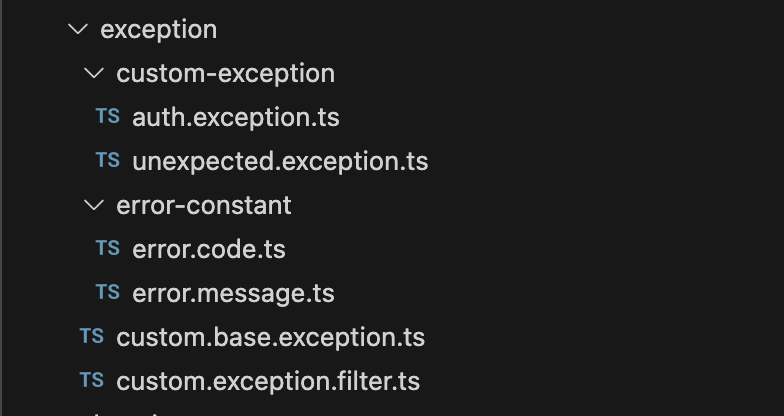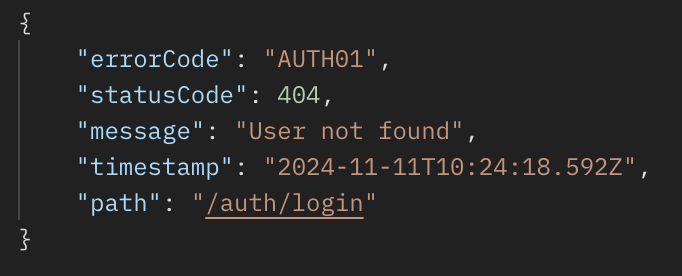Implementing Custom Error Handling in NestJS

Error handling is essential for system maintainability. In my experience as a front-end developer, I frequently relied on backend developers to investigate specific errors, especially in mobile applications where detailed developer consoles are less accessible. To address this, I created a custom error-handling method with the following three objectives:
- Enable handling by error code (distinct from status code).
- Provide a quick understanding of the error context.
- Facilitate backend error tracking via structured logs.

Custom Exception Implementation
Base Exception
I wanted the base exception to include an error code (separate from the status code) that consists of a section identifier and a unique code, like AUTH01. Additionally, I embedded the API path, timestamp, and a predefined message for streamlined logging.
// custom.base.exception.ts
export abstract class CustomBaseException extends HttpException {
protected constructor(
errorCode: string,
statusCode: number,
message: string,
) {
super(message, statusCode);
this.errorCode = errorCode;
this.timestamp = new Date().toISOString();
}
errorCode: string;
timestamp: string;
}
CustomBaseException extends HttpException (NestJS’s default error handler) and includes error-related data fields such as errorCode, statusCode, timestamp, path, and message. The abstract and protected modifiers prevent instantiation of CustomBaseException directly, enforcing the use of subclass constructors only.
Custom Error Codes
To manage error codes systematically, I used enums organized by domain (e.g., authentication). Each error within a domain has a unique code, making it easy to identify the origin and type of error at a glance.
// error-constant/error.code.ts
export enum AuthErrorCodeEnum {
UserNotFound = 'AUTH01',
PasswordNotMatch = 'AUTH02',
PasswordHashFailed = 'AUTH03',
EmailAlreadyExists = 'AUTH04',
// ...etc
}
Custom Error Message
Error messages are mapped to error codes, providing a consistent message for each error. This approach minimizes risks of typographical errors and eliminates the need to define messages dynamically each time an error is thrown.
// error-constant/error.message.ts
type AuthErrorMessageType = {
readonly [K in AuthErrorCodeEnum]: string;
};
export const AuthErrorMessage: AuthErrorMessageType = {
[AuthErrorCodeEnum.LogoutFailed]: 'Logout failed',
[AuthErrorCodeEnum.UserNotFound]: 'User not found',
[AuthErrorCodeEnum.PasswordNotMatch]: 'Password not match',
[AuthErrorCodeEnum.PasswordHashFailed]: 'Password hash failed',
[AuthErrorCodeEnum.EmailAlreadyExists]: 'Email already exists',
// ...etc
};
Custom Exception
With the base exception, error codes, and messages defined, we can now create custom exception classes by extending the base class and passing specific data.
// custom-exception/auth.exception.ts
export class UserNotFoundException extends CustomBaseException {
constructor() {
super(
AuthErrorCodeEnum.UserNotFound,
HttpStatus.NOT_FOUND,
AuthErrorMessage[AuthErrorCodeEnum.UserNotFound],
);
}
}
// ..other exceptions
Using this setup, custom exceptions can be instantiated by simply throwing a new exception, with clear error codes, messages, and HTTP status mappings for each case. Please check beneath to use appropriate status.
export declare enum HttpStatus {
CONTINUE = 100,
SWITCHING_PROTOCOLS = 101,
PROCESSING = 102,
EARLYHINTS = 103,
OK = 200,
CREATED = 201,
ACCEPTED = 202,
NON_AUTHORITATIVE_INFORMATION = 203,
NO_CONTENT = 204,
RESET_CONTENT = 205,
PARTIAL_CONTENT = 206,
AMBIGUOUS = 300,
MOVED_PERMANENTLY = 301,
FOUND = 302,
SEE_OTHER = 303,
NOT_MODIFIED = 304,
TEMPORARY_REDIRECT = 307,
PERMANENT_REDIRECT = 308,
BAD_REQUEST = 400,
UNAUTHORIZED = 401,
PAYMENT_REQUIRED = 402,
FORBIDDEN = 403,
NOT_FOUND = 404,
METHOD_NOT_ALLOWED = 405,
NOT_ACCEPTABLE = 406,
PROXY_AUTHENTICATION_REQUIRED = 407,
REQUEST_TIMEOUT = 408,
CONFLICT = 409,
GONE = 410,
LENGTH_REQUIRED = 411,
PRECONDITION_FAILED = 412,
PAYLOAD_TOO_LARGE = 413,
URI_TOO_LONG = 414,
UNSUPPORTED_MEDIA_TYPE = 415,
REQUESTED_RANGE_NOT_SATISFIABLE = 416,
EXPECTATION_FAILED = 417,
I_AM_A_TEAPOT = 418,
MISDIRECTED = 421,
UNPROCESSABLE_ENTITY = 422,
FAILED_DEPENDENCY = 424,
PRECONDITION_REQUIRED = 428,
TOO_MANY_REQUESTS = 429,
INTERNAL_SERVER_ERROR = 500,
NOT_IMPLEMENTED = 501,
BAD_GATEWAY = 502,
SERVICE_UNAVAILABLE = 503,
GATEWAY_TIMEOUT = 504,
HTTP_VERSION_NOT_SUPPORTED = 505
}
Custom Exception Filter
To centralize error handling, I implemented a custom exception filter. This filter catches errors, formats the response, and logs necessary details to the console.
// custom.exception.filter.ts
@Catch()
export class CustomExceptionFilter implements ExceptionFilter {
private readonly logger = new Logger(CustomExceptionFilter.name);
catch(exception: Error | CustomBaseException, host: ArgumentsHost): void {
const ctx = host.switchToHttp();
const request = ctx.getRequest();
const response = ctx.getResponse();
const res =
exception instanceof CustomBaseException
? exception
: new UnexpectedException();
const errorResponse = {
errorCode: res.errorCode,
statusCode: res.getStatus(),
message: res.message,
timestamp: res.timestamp,
path: request.url,
};
this.logger.error({
...errorResponse,
...(!(exception instanceof CustomBaseException) && {
stack: exception.stack,
originalError: exception,
}),
});
response.status(res.getStatus()).json(errorResponse);
}
}
The CustomExceptionFilter retrieves request and response data and logs all error information for easy review. Non-custom errors are wrapped in a generic UnexpectedException to ensure unhandled errors are managed consistently.
Finally, in main.ts, I register the custom exception filter globally:
// main.ts
async function bootstrap() {
const app = await NestFactory.create(AppModule);
app.useGlobalFilters(new CustomExceptionFilter());
await app.listen(3000);
}
bootstrap();
Usage in Code
Here’s an example of how to use the custom exceptions in a service method:
async validateAuthentication(loginDto: LocalLoginRequestDto) {
const user = await this.usersService.findUserForAuth(loginDto.email);
if (!user) {
throw new UserNotFoundException();
}
// ...other logic
}
Error Response

Upon encountering an error, the response includes details such as the error code, message, path, and timestamp, making it easy to identify and resolve issues without memorizing specific error codes.
Considerations
Using error codes can improve error tracking without communication overhead, but if working within a team, be mindful of sharing error codes promptly to maintain clarity.
